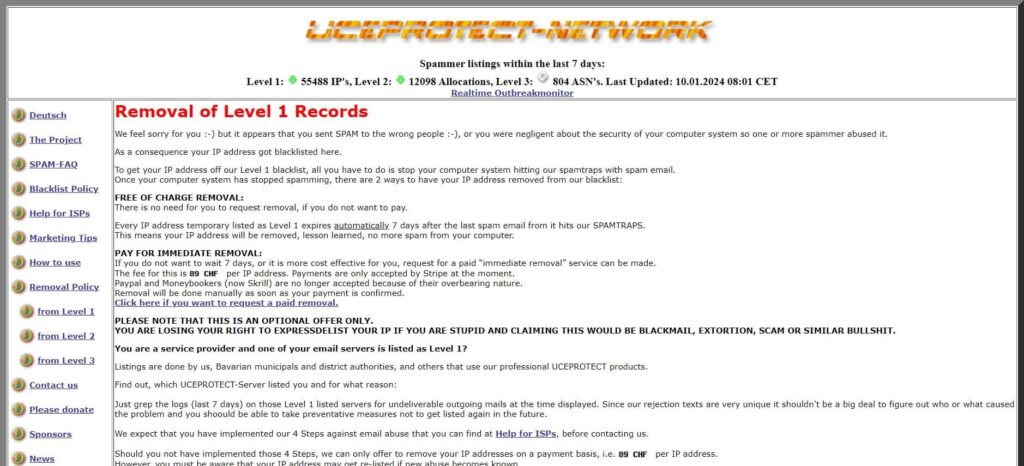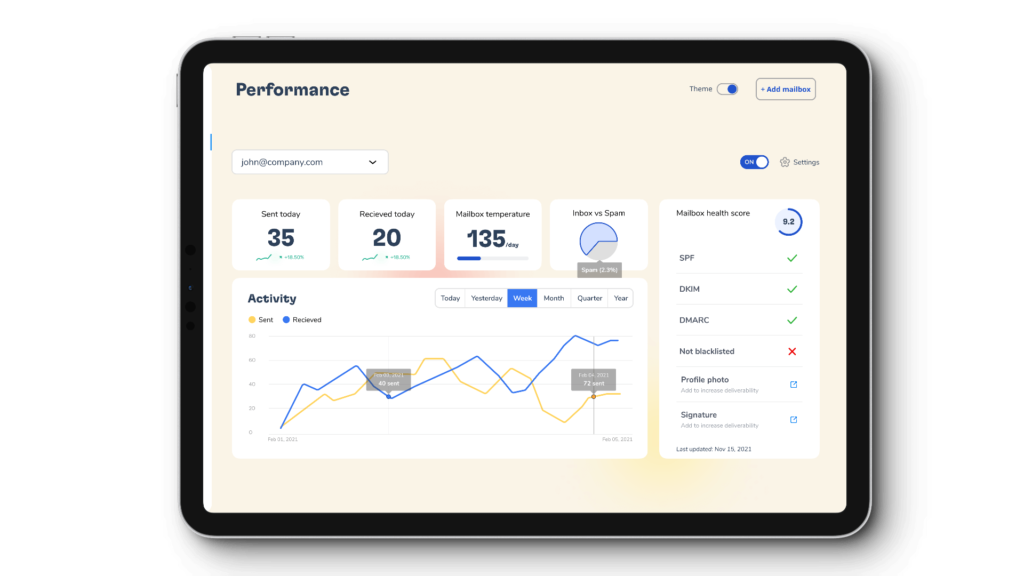UCEPROTECTL1 Blacklist: What is it & How to Remove [SOLVED]
TABLE OF CONTENTS
In the intricate world of email deliverability, the UCEPROTECTL1 Blacklist emerges as a crucial factor that can significantly influence the journey of your digital correspondence. This blacklist, a dynamic tool in the realm of online communication, serves as a gatekeeper, determining the fate of emails based on the reputation of their originating IP addresses. Understanding the nuances of the UCEPROTECTL1 Blacklist is not just beneficial but essential for anyone who relies on email as a primary mode of communication, be it for personal outreach or large-scale business engagement.
This article is designed to be a comprehensive guide, illuminating the intricacies of the UCEPROTECTL1 Blacklist. We delve into the core of what it is, unravel the common causes that might lead to your IP address being blacklisted, and most importantly, offer a detailed roadmap for removal and future prevention. By understanding these elements, you can safeguard your email deliverability, ensuring your messages reach their intended destinations unimpeded. Let’s embark on this informative journey, equipping you with the knowledge and tools necessary to master the art of email deliverability in the context of UCEPROTECTL1.
Understanding UCEPROTECTL1 blacklist

What is UCEPROTECTL1?
UCEPROTECTL1, a term often encountered in the labyrinthine world of email management, stands as a pivotal blacklist system. This system meticulously monitors IP addresses, identifying and flagging those implicated in sending unsolicited emails.
Essentially, UCEPROTECTL1 operates as a watchdog, maintaining the sanctity of email inboxes by filtering out potential spam from reputable correspondence. Its role is critical in upholding the integrity of email communication, ensuring that only legitimate, welcomed messages navigate through the digital pathways to their intended recipients.
How it Affects Email Deliverability
The impact of being listed on the UCEPROTECTL1 Blacklist on email deliverability is both immediate and profound. Emails originating from blacklisted IPs face the harsh reality of being rejected or relegated to spam folders, never reaching their target audience.
This outcome not only disrupts the flow of communication but can also inflict lasting damage on the sender’s reputation and credibility. In the digital age, where email is a cornerstone of professional and personal interactions, being blacklisted can translate to missed opportunities, eroded trust, and a challenging road to recovery in establishing digital reliability.
Common Reasons for Ending Up on the UCEPROTECTL1 Blacklist
Landing on the UCEPROTECTL1 Blacklist is not a random misfortune but typically the result of specific actions or oversights. Common culprits include the emission of spam or mass unsolicited emails, compromised email servers being exploited for spam distribution, and inadequate security measures leading to the IP being hijacked for malicious purposes.
Additionally, failing to adhere to best practices in email list management, such as neglecting to obtain explicit consent from recipients or not promptly removing uninterested parties, can trigger a red flag with UCEPROTECTL1. Understanding these pitfalls is the first step in both avoiding blacklist entanglements and initiating effective remediation strategies.
Reasons you might be blacklisted
Overview of Typical Activities Leading to Blacklisting
Engagement in Unsolicited Email Campaigns
Often, the primary reason for finding oneself on a blacklist like UCEPROTECTL1 is the distribution of unsolicited emails. This encompasses a range of activities from mass email blasts to targeted but unrequested communication.
Compromised Email Security
Instances where your email server is hijacked or used by unauthorized entities to dispatch spam can lead to blacklisting. This scenario underscores the necessity of robust email security protocols.
Inadequate Email List Management
Poor management practices, such as not validating email addresses or failing to honor unsubscribe requests, can inadvertently result in your IP being flagged as a source of spam.
Detailed Examples of Policy Violations or Security Breaches
Sending Emails Without Consent
Dispatching emails to recipients who have not explicitly agreed to receive them is a direct violation of many anti-spam policies, precipitating a blacklist inclusion.
Neglecting Email Authentication Protocols
Failing to implement standards like SPF, DKIM, and DMARC can make your emails appear suspicious, increasing the risk of being marked as spam.
Take the first step towards securing your email delivery with Warmy’s Free SPF Record Generator. Our user-friendly tool simplifies the creation of SPF records to protect your domain against spoofing and ensure your emails reach their intended destination. Don’t let your messages get sidelined by spam filters. Visit Free SPF Record Generator and fortify your email authenticity today. It’s quick, easy, and absolutely free!
Data Breaches Leading to Email Abuse
Instances where your email system is compromised, leading to unauthorized access and use for spamming purposes, are severe security breaches that can land you on a blacklist.
The Role of Spam Traps and User Complaints
Spam Traps
These are email addresses set up specifically to catch spammers. Sending emails to these addresses, often due to outdated or improperly acquired email lists, can result in immediate blacklisting.
High Volume of User Complaints
If a significant number of recipients mark your emails as spam, this is a strong indicator to email service providers and blacklisting entities like UCEPROTECTL1 that your communications may be unwelcome.
Repeated Offenses
Consistently engaging in practices that trigger spam filters or user complaints will not only get you blacklisted but can also make it more challenging to be removed from such lists in the future.
Steps to remove your IP from UCEPROTECTL1
To remove your IP from the UCEPROTECTL1 Blacklist, there are two main options:
Free Removal
This occurs automatically. If no spam is sent from your IP to their spam traps for 7 days, your IP will be removed from the Level 1 blacklist without any action needed on your part.
Paid Immediate Removal
If you can’t wait for the 7-day period, there is an option for immediate removal through a paid service. The fee is specific per IP address and payment is currently accepted through Stripe. After payment, the removal is processed manually.
It’s important to understand the reason behind your listing to prevent future occurrences. You can investigate this by checking your server logs for outgoing mail issues, especially looking for unique rejection texts from UCEPROTECT. Additionally, implementing recommended steps against email abuse is crucial for maintaining a clean IP reputation.
Steps to remove your IP from UCEPROTECTL1
Best Practices for Maintaining a Clean IP Reputation
- Regularly Monitor Email Activity. Keep a vigilant eye on your email sending patterns and volumes. Unexpected spikes in activity can be a red flag for spam-like behavior.
- Implement Email Authentication Protocols. Utilize tools like SPF, DKIM, and DMARC to authenticate your emails, making them less likely to be marked as spam.
- Clean Your Email Lists Regularly. Routinely remove inactive, unresponsive, or bounced email addresses to ensure a healthy, engaged recipient list.
Monitoring Tools and Services for Preemptive Action
- Utilize Reputation Monitoring Services. Employ services that monitor your IP and domain reputation in real-time, alerting you to potential issues before they escalate.
- Engage in Proactive Blacklist Checks. Regularly check if your IP is listed on any blacklists and take immediate corrective action if it is.
- Leverage Email Warm-Up Services like Warmy.io. Use email warm-up services to gradually build your sender’s reputation by sending emails from new domains or IPs to a network of real people who interact with these emails.
Developing a Robust Email Sending Policy
- Establish Clear Email Content Guidelines. Develop and adhere to a set of standards for your email content to avoid triggering spam filters.
- Educate Your Team on Best Practices. Ensure that everyone involved in your email campaigns understands the importance of responsible email practices.
- Maintain Transparency and Compliance. Be transparent with your email recipients about what they are signing up for, and always comply with email regulations like CAN-SPAM.
Differences between UCEPROTECTL1, UCEPROTECTL2, and UCEPROTECTL3
Levels of UCEPROTECT Blacklists Explained
- UCEPROTECTL1. Targets individual IP addresses known for sending spam.
- UCEPROTECTL2. Escalates to network-level blacklisting, affecting ranges of IPs from a single provider if multiple IPs are involved in spamming activities.
- UCEPROTECTL3. Affects entire Autonomous Systems (AS) when a significant proportion of their IPs are found to be spamming.
Read also – Uceprotectl3 blacklist: How To Remove your IP from it
Specific Triggers and Consequences of Each Level
- UCEPROTECTL1 Trigger: Direct result of spam activity from a single IP.
- UCEPROTECTL2 Consequence: Wider impact, where even non-spamming IPs in the same network range may face deliverability issues.
- UCEPROTECTL3 Trigger: Systemic issue within a network, indicating widespread tolerance or neglect of spam activities.
You might be interested – Uceprotectl2: How To Remove your IP from blacklist | Warmy.io
Strategies for Dealing with Different Levels of Blacklisting
- Level 1 Response: Focus on securing the individual IP and improving its email practices.
- Level 2 & 3 Strategies: Involve higher-level network analysis and engagement with ISP or network administrators to address broader issues contributing to spam.
Warmy.io: your solution against UCEPROTECTL1 blacklisting

To ensure your emails consistently reach their target audience without the risk of being blacklisted on UCEPROTECTL1, consider using Warmy.io, an email warm-up service.
Warmy.io gradually builds up your sender reputation by systematically increasing email volume, thus helping you avoid sudden spikes that might trigger spam filters.
By using Warmy.io, you’re not just safeguarding your emails from being marked as spam; you’re also enhancing your overall email deliverability. This proactive approach is key in maintaining a positive email sending reputation and staying off blacklists like UCEPROTECTL1.
Start using Warmy.io today and ensure your emails make it to their intended inboxes every time.
Conclusion
In conclusion, navigating the complexities of UCEPROTECTL1 Blacklist and its higher levels, UCEPROTECTL2 and UCEPROTECTL3, is a vital aspect of maintaining email deliverability and reputation. Understanding the nuances of each level, the specific triggers leading to blacklisting, and adopting effective strategies for removal and prevention are key.
The journey from detection to resolution involves proactive monitoring, adherence to best email practices, and sometimes, direct engagement with the blacklist authorities. This guide provides a comprehensive roadmap to manage your presence on the UCEPROTECTL1 Blacklist, ensuring your emails reach their intended audience without hindrance. Remember, vigilance and continuous improvement in email practices are your best allies in preserving a trusted digital communication channel.
FAQ
UCEPROTECT Documentation and Removal Tools
For comprehensive information on UCEPROTECT, including detailed documentation and instructions for IP removal, visit UCEPROTECT's Official Website.
What is UCEPROTECTL1 Blacklist?
UCEPROTECTL1 is a blacklist that identifies IP addresses involved in sending spam. It helps email providers filter out unwanted emails.
How does an IP get listed on UCEPROTECTL1?
IPs are listed for sending spam or being part of a network that sends large volumes of unsolicited emails.
What are the steps to remove my IP from UCEPROTECTL1?
IPs are automatically delisted after 7 days of no spam activity. Alternatively, a paid immediate removal option is available.
Can I prevent being listed on UCEPROTECTL1?
Yes, by following best email practices, such as using email warm-up services, maintaining clean email lists, and implementing proper email authentication protocols

